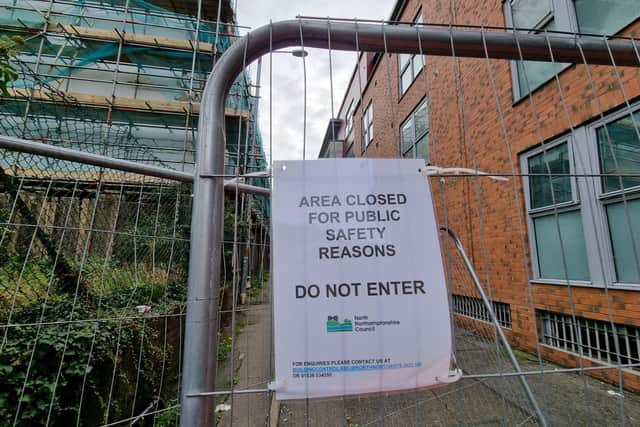Kettering Job's Yard developer misses High Court case deciding fate of flats to carry on building unlawful storeys
and live on Freeview channel 276
The director of a company responsible for an unlawful building in Kettering town centre failed to appear at the High Court on Wednesday at the latest case to decide the flats’ fate.
Marcus Fielding, sole director of Michigan Construction Ltd, had been due to attend the Technology & Construction Court in Birmingham – a regional centre for the High Court.
Advertisement
Hide AdAdvertisement
Hide AdAs the civil court hearing started on Wednesday, witnesses back in Kettering reported seeing Mr Fielding working on the planning permission-breaching apartments in Job’s Yard.


Despite his absence, the case brought by planning authority North Northamptonshire Council (NNC) went ahead in front of Her Honour Judge Sarah Watson.
In June, a final offer had been made to the developer to ‘take responsibility’ and engage with NCC to remediate building defects and demolish the non-compliant two top storeys.
A ‘mutually agreed proposal’ presented to Judge Watson and agreed in court formed a court order with a strict timeline of activities.


Advertisement
Hide AdAdvertisement
Hide AdBut instead of demolishing the extra floors as agreed using a contractor, back to four storeys allowed by planning permission, building works have continued with the roof nearing completion and windows installed.
Simon Goldberg KC, for NNC said: “The company (Michigan Construction Ltd) didn’t have the money to find a (demolition) expert. He does have the wherewithal for 30 to 40 windows – his arguments are built on sand. It has got the money, but it’s decided to use it on breaching flagrantly the order.”
Mr Goldberg catalogued attempts made by the council’s building control department to engage with Mr Fielding since he started the Job’s Yard project. Numerous communications via letter, email, phone calls and face-to-face meetings failed to get all the paperwork required by inspectors.
Structural engineer David Smith of David Smith Associates told the court he had visited the site several times to produce reports on the state of the building.
Advertisement
Hide AdAdvertisement
Hide AdMr Smith said he had ‘serious concerns’ about the structure warning that over time the building was at risk of collapse.
When asked by Mr Mendosa KC representing Mr Fielding’s financial provider M.A.X. Funding Limited, if the fifth and sixth floor were taken off there would still be ‘big problems’, Mr Smith replied “no doubt”. He added that he had ‘significant concerns’ about the construction.
Detailed reports written by Mr Smith revealed metal ties used to join masonry walls together could not be located. Evidence pieced together by Mr Smith, from Mr Fielding’s invoices submitted to the court as evidence, suggested blocks used to build walls were the wrong size and would be too weak to hold the weight of the building.
At the start of the build, when building control officers visited the Job’s Yard site to inspect progress on the foundations, council officer George Parker was shown a video by Mr Fielding on his phone of the work and ‘led to believe the foundations had been designed by an architect’. Repeated follow-up requests for documentation including plans were not forthcoming.
Advertisement
Hide AdAdvertisement
Hide AdThe court heard many attempts had been made to assess the safety of the foundations and if their depth and width dug for the original three-storey planned structure would have the necessary strength for a six-storey building.
Judge Watson said: “I’m no physicist but the foundations are half as wide as they should be.”
She likened attempts to working on the building with the existing foundations as ‘rearranging the deckchairs on the Titanic’.
Asked whether the building could be reduced to two storeys, Mr Smith said: “In my opinion as someone with 35 years experience of refurbishment of buildings, I still have issues with the foundations. There are a large number of defects. There’s still issues – you can’t resolve all that. Serious consideration should be given to take it down to ground level.”
Advertisement
Hide AdAdvertisement
Hide AdStructural engineer Emmanouil Moudatsos had produced a report for Michigan Construction Ltd but made it clear he did not design the foundations or know what had been built.
He was asked about the ground the apartments had been built on.
Using the Leaning Tower of Pisa as an example, Mr Moudatsos said: “You need to be very careful when it comes to foundations. I haven’t ever done a soil investigation but it depends whether it’s a three-storey building or a skyscraper. The foundations and ground floor had already been constructed before our engagement by Mr Fielding. What is evident to us is that no engineer had been appointed to design the foundations.”
Built on the Northampton Sands Formation commonly found across the county, the court heard the rock can contain pockets of sand, some clay and flaking layers. The only way to know the load capacity of ground is carrying out borehole tests on site.
Advertisement
Hide AdAdvertisement
Hide AdJudge Watson added: “The real question in this case that nobody knows the answer to is what the capacity of this ground (the Job’s Yard site) really was.”
The case continues today (Thursday, November 16).